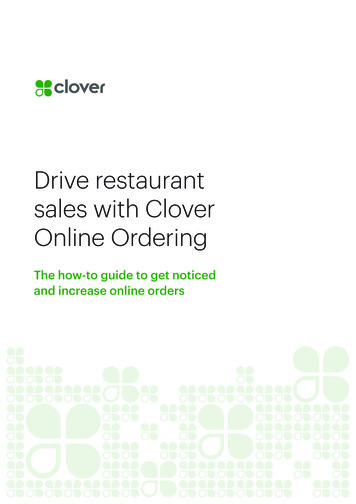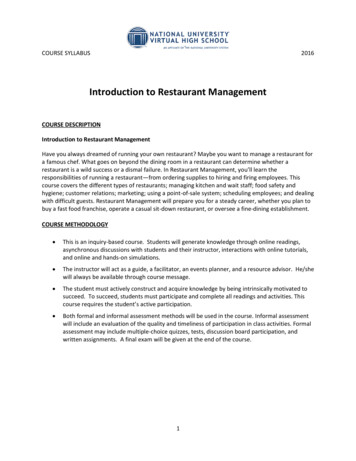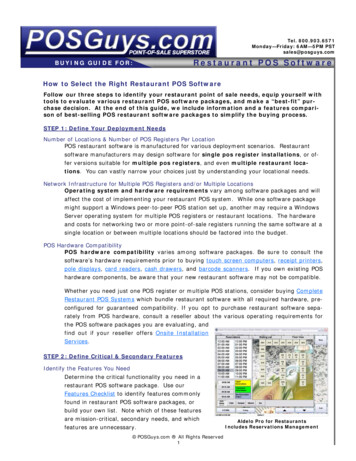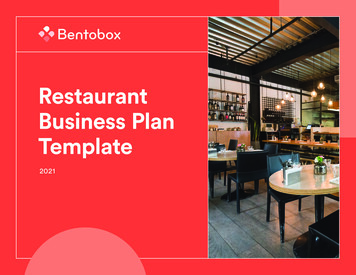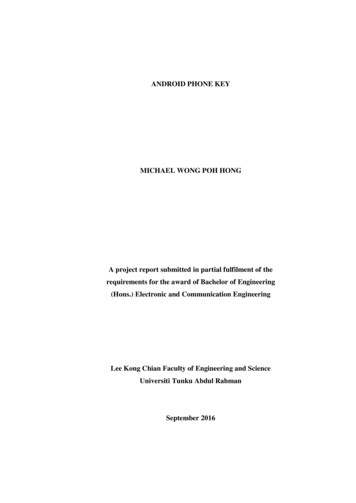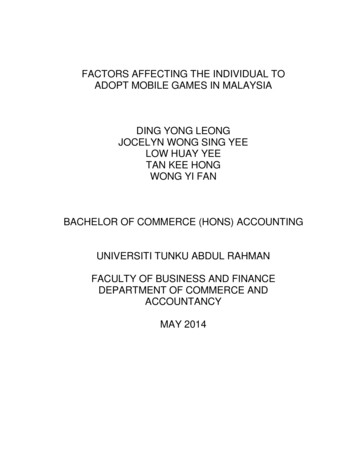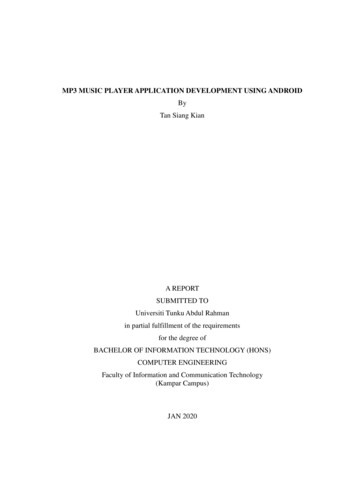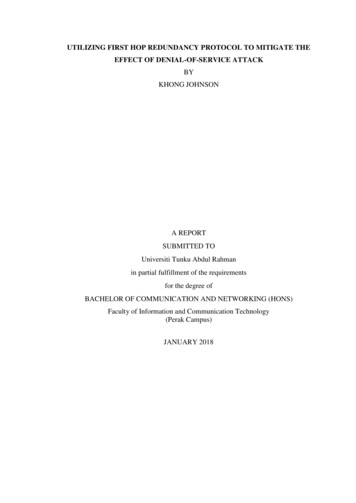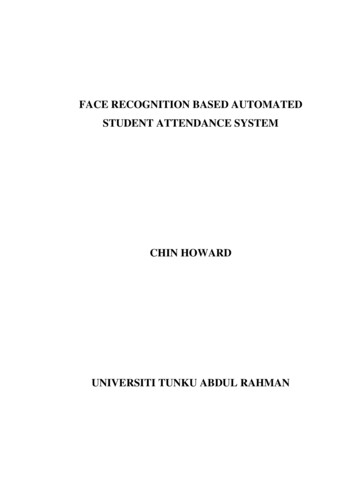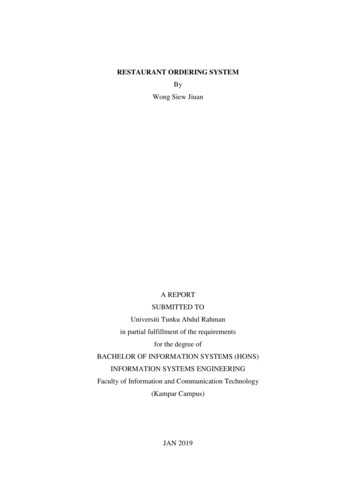
Transcription
RESTAURANT ORDERING SYSTEMByWong Siew JiuanA REPORTSUBMITTED TOUniversiti Tunku Abdul Rahmanin partial fulfillment of the requirementsfor the degree ofBACHELOR OF INFORMATION SYSTEMS (HONS)INFORMATION SYSTEMS ENGINEERINGFaculty of Information and Communication Technology(Kampar Campus)JAN 2019
UNIVERSITI TUNKU ABDUL RAHMANREPORT STATUS DECLARATION FORMTitle:Academic Session:I(CAPITAL LETTER)declare that I allow this Final Year Project Report to be kept inUniversiti Tunku Abdul Rahman Library subject to the regulations as follows:1.The dissertation is a property of the Library.2.The Library is allowed to make copies of this dissertation for academic purposes.Verified by,(Author’s signature)(Supervisor’s signature)Address:Supervisor’s nameDate:Date:
RESTAURANT ORDERING SYSTEMByWong Siew JiuanA REPORTSUBMITTED TOUniversiti Tunku Abdul Rahmanin partial fulfillment of the requirementsfor the degree ofBACHELOR OF INFORMATION SYSTEMS (HONS)INFORMATION SYSTEMS ENGINEERINGFaculty of Information and Communication Technology(Kampar Campus)JAN 2019
DECLARATION OF ORIGINALITYI declare that this report entitled “RESTAURANT ORDERING SYSTEM” is my own workexcept as cited in the references. The report has not been accepted for any degree and is notbeing submitted concurrently in candidature for any degree or other award.Signature:Name:Date:BIS (Hons) Information Systems EngineeringFaculty of Information and Communication Technology (Kampar Campus), UTAR.iii
ACKNOWLEDGEMENTI would like to express my sincere thanks and appreciation to my supervisor, Mr Tey CheeChieh who has given me this bright opportunity to engage in Restaurant Ordering Systemproject. A million thanks to you. I also would like to thanks my friends for their support andencouragement. Finally, I must say thanks to my parents and my family for their love, supportand continuous encouragement throughout the course.BIS (Hons) Information Systems EngineeringFaculty of Information and Communication Technology (Kampar Campus), UTAR.iv
ABSTRACTThis Restaurant Ordering System project is developed to transform the old and traditionalsystem that mostly used by the restaurants to a new and more efficient ordering system. Thetraditional ordering system brings inconvenience to both staffs and customers as it requires alot of manual work. The manual work done by the staffs will cause some human errors such asgive the incorrect bill to the customers, ugly handwriting of the waiter, incorrect sequence ofthe order. All these human errors will cause the customer dissatisfaction towards the restaurant.Therefore, this restaurant ordering system is designed and developed to help the restaurant tohave a better management. By having this ordering system, the time of placing order hasreduced. The customers do not need to wait to be served when they eat in the restaurant. Thecustomers will be more satisfy at this ordering system.The methodology that used to develop this system is throwaway prototyping methodology.This methodology is chosen because the system will be developed in a shirt time compare toother methodologies. Throwaway prototyping methodology also allows the developer to listento the feedback of the end user to keep on working on the development to match therequirements of the end user.BIS (Hons) Information Systems EngineeringFaculty of Information and Communication Technology (Kampar Campus), UTAR.v
Table of ContentsTABLE OF CONTENTSREPORT STATUS DECLARATION FORMiTITLE PAGEiiDECLARATION OF ORIGINALITYiiiACKNOWLEDGEMENTivABSTRACTvTABLE OF CONTENTSviLIST OF FIGURESviiiLIST OF TABLESxCHAPTER 11INTRODUCTION1.1Problem Statement11.2Background and Motivation21.3Objectives31.4Proposed Approach/Study41.5Highlight of What Have Been Achieved51.6Report of Organization5CHAPTER 2LITERATURE REVIEW62.1Wireless Food Ordering System62.2Point of Sale System82.3Online Ordering System92.4Comparison Between Similar SystemsCHAPTER 33.1SYSTEM DESIGNBlock Diagram111212BIS (Hons) Information Systems EngineeringFaculty of Information and Communication Technology (Kampar Campus), UTAR.vi
Table of Contents3.2Use Case Diagram133.3Activity Diagram153.3.1 Place Order153.3.2 Change Order Status of Customers163.3.3 Update Menu173.3.4 Update Category183.3.5 Delete Menu193.3.6 Delete Category203.3.7 Create Menu213.3.8 Create Category22User Interface Design233.4CHAPTER 4METHODOLOGY AND .4Timeline334.5Implementation and Testing34CHAPTER 5CONCLUSION375.1Conclusion375.2Project Discussion375.3Future Work38BIBLIOGRAPHY39BIS (Hons) Information Systems EngineeringFaculty of Information and Communication Technology (Kampar Campus), UTAR.vii
List of FiguresLIST OF FIGURESFigure NumberTitlePageFigure 1-1System Flowchart of Restaurant Ordering System4Figure 2-1Mobile Applications: Architecture, Design and Development.6Figure 2-2Logical Wireless Diagram.7Figure 2-3POS Architecture Diagram.8Figure 2-4Online Ordering System Context Diagram.10Figure 3-1Block Diagram12Figure 3-2Use Case Diagram of Restaurant Ordering System13Figure 3-3Activity Diagram for Customers to Place Order15Figure 3-4Activity Diagram for Staff and Chef to Change Order Status 16of CustomersFigure 3-5Activity Diagram for Staff to Update Menu17Figure 3-6Activity Diagram for Staff to Update Category18Figure 3-7Activity Diagram for Staff to Delete Menu19Figure 3-8Activity Diagram for Staff to Delete Category20Figure 3-9Activity Diagram for Staff to Create Menu21Figure 3-10Activity Diagram for Staff to Create Category22Figure 3-11Home Page23Figure 3-12Menu Page23Figure 3-13Order Page Part 124Figure 3-14Order Page Part 224Figure 3-15Admin Login Page25Figure 3-16Sales Page Part 125Figure 3-17Sales Page Part 226Figure 3-18Products Page26Figure 3-19Update Menu27Figure 3-20Delete Menu27Figure 3-21Add Menu28Figure 3-22Category Page28BIS (Hons) Information Systems EngineeringFaculty of Information and Communication Technology (Kampar Campus), UTAR.viii
List of FiguresFigure 3-23Update Category29Figure 3-24Delete Category29Figure 3-25Add Category30Figure 3-26Chef Home Page30Figure 4-1Diagram of Throwaway Prototyping model31Figure 4-2Timeline for Project 133Figure 4-3Timeline for Project 233Figure 4-4Timeline for Project 2 (cont)33BIS (Hons) Information Systems EngineeringFaculty of Information and Communication Technology (Kampar Campus), UTAR.ix
List of TablesLIST OF TABLESTable NumberTitlePageTable 2-1Comparison between existing systems with proposed11systemBIS (Hons) Information Systems EngineeringFaculty of Information and Communication Technology (Kampar Campus), UTAR.x
Chapter 1 IntroductionChapter 1 Introduction1.1 Problem StatementNowadays, many restaurant using traditional restaurant ordering system to serve customers. Inthe traditional restaurant ordering system, the staff write down the foods that the customerorder. The paper will then pass to the kitchen and the chef will start to cook. This has causedfew inconveniences. The staff might make some errors while writing down the order.Sometimes, when the staff write in hurry will make the handwriting difficult to understand.The staff might lose the order paper and customers might also receive incorrect bill.One of the problem that faced by restaurants that using traditional ordering system is thecustomers do not know the time for preparation for the food. Some of the customers might havenext schedule after their lunch or dinner. They need to know the time preparation so that theycan plan their schedule wisely. Especially when there is a lot of customers, the customers mightthink their order has been forgotten if their food still not yet be served in a long time. It will begood if there is an estimated time to prepare the food shown to the customers.Furthermore, some of the customers might want to change their food or cancel their food. Thecustomers are only allowed to cancel their order if the chef not yet start cooking. If using thetraditional restaurant ordering system, the customers need to inform the staff, then the staffonly inform to the chef. If there is a lot customer in the restaurants, the staff might forget toinform to the chef. The staff might also too late approach the chef and the customers are unableto cancel their order. This problem should be solved because it is inconvenient for thecustomers. It is much more convenient for customers if they can cancel their order themselves.They no need wait the staff to serve them and waste the time. A cancel button should bedisplayed so that the customers can cancel their order if the chef not yet start cooking.Moreover, it is difficult to update the latest information to the customers. The availability ofthe dishes is according to the ingredients that bought every day. When there is lack ofingredients, the chef is unable to prepare some of the dishes. Therefore, it is difficult to informevery customer when they want to order. The staff might forget to inform the customers. Asthey have many things to do. If the customers already order and feel excited to taste the dishes,but the staff inform them the dishes is unable to order due to lack of ingredients. This will causethe customer dissatisfaction towards the restaurant. The brand image of the restaurant will beaffected.BIS (Hons) Information Systems EngineeringFaculty of Information and Communication Technology (Kampar Campus), UTAR.1
Chapter 1 Introduction1.2 Background and motivationPeople like to dine in at restaurant for their meals nowadays. There are a lot reasons why peopleprefer eating out. One of the reasons is they lazy to cook after work. People will feel tired aftermore than 7 hours of work. Therefore, they do not have any energy to prepare their meals. Inaddition, university students have a lot of works to do, such as assignments, tutorials and takepart in curriculum activities. It will be more convenient if they eat in restaurant compare to theycook themselves. As more and more people eat in the restaurant, the restaurant manager shouldmake some changes to increase the speed of ordering.Traditionally, the customers need to interact with the waiters to place order. The waiters writedown the foods that the customer order. The paper will then pass to the kitchen and the chefwill start to cook. The customers have faced a lot inconveniences with this traditional method.For example, waiting to get the food served, received incorrect bill and many more. All thisinconvenience will cause the customers unsatisfied on the service of the restaurant.The customers are demanding simplification tasks such as book movie tickets nowadays.Therefore, restaurant also should make changes. With the new changes, the customers canmake their order through restaurant ordering system. The customers do not need to wait to beserved usually at the peak hours. After they order themselves using the ordering system, theyjust need to wait for the food.In conclusion, this report is written to propose a restaurant ordering system. This system canhelp to improve the current ordering method. Furthermore, it also brings convenient to bothrestaurant and customers. After this project has done, this system will be very useful for manyrestaurants.BIS (Hons) Information Systems EngineeringFaculty of Information and Communication Technology (Kampar Campus), UTAR.2
Chapter 1 Introduction1.3 Objectives To develop a system that include the preparation time of foodBy using this restaurant ordering system, it is easier to know the time preparation of the food.The customers might have their own schedule after their lunch or dinner. Therefore, they needto know the preparation time of food in order to plan their schedule wisely. During the peakhours, when their food is not yet being served in a long time, they might think that their orderhas been forgotten. By having this feature in the system, the customers can know the estimatedtime preparation of the food. They can check the estimated preparation time anytime and knowthat their order will not be forgotten by the chef. To ensure the customers can cancel their orderThe restaurant that using traditional method include many steps when customers wish to canceltheir order. The customers need to inform the staff, then the staff will inform the chef. In thisrestaurant ordering system, the customers can cancel their order without interact with the staff.They can just click on the cancel button to cancel their order. The customers can cancel theirorder with one condition which is the chef not yet prepare their food. If the chef started toprepare the food, the customers are not allowed to cancel their order. When the chef starts toprepare the food, he or she will change the status of the order. The status of the order will showto the customers so that the customers can know whether their order has prepared by the chefor not. To design a user-friendly system that provides latest information to customersThis restaurant ordering system allows both staffs and chefs to update the latest information ofthe menu to the customers. When there is lack of ingredients, the chef should be able to changethe menu and the availability of each food. If the food is not available, the food will not appearin the menu. When the customers view the menu, they can’t view the food. This can solve theproblem of staff forgot to inform the latest information to customers. The user interface of thesystem should also be clean and clear and also attractive to the user. The system should be easyto use by the users. A user-friendly system is when the customers use the system in the firsttime, they know how to view the menu and make their order. The system also should not becomplexity as the customers might do not know how to use it.BIS (Hons) Information Systems EngineeringFaculty of Information and Communication Technology (Kampar Campus), UTAR.3
Chapter 1 Introduction1.4 Proposed Approach/StudyFigure 1-1 System Flowchart of Restaurant Ordering SystemFigure 1-1 shows the system flowchart of Restaurant Ordering System. When the customerswalk in to the restaurant, the staff will serve the customers to sit down. Then, the customerswill use the device that provided by the restaurant to view the food menu. Then, the customerscan order their food. After the customers fill in the quantity of the food and the table name andsubmit the order, the chef and the staff will receive the order details of the customers. If thefood is started to prepare, the chef will change the order status of the customers. After the foodis ready, the staff will serve the customers with the food. After all the food has been served,the staff will change the status of the order.BIS (Hons) Information Systems EngineeringFaculty of Information and Communication Technology (Kampar Campus), UTAR.4
Chapter 1 Introduction1.5 Highlight of What Have Been AchievedThis restaurant ordering system is developed to solve the problems that will happen while usingtraditional ordering system. One of the problem that faced by restaurant using traditionalordering system is do not know the time of preparation for the food. This developed restaurantordering system allow the customers to know the preparation time of their order. Therefore,they can easily plan their next schedule after their meal. Moreover, the customers might wantto cancel their food. If using traditional ordering system, the cancellation of order includes fewsteps. However, in this restaurant ordering system, the customers can press cancel button tocancel their order. The chef will know it from the dashboard of the system. Furthermore, it isdifficult to tell all the customers the latest information of the menu when taking order ofcustomers. The staff might forget to inform the customers. With this restaurant orderingsystem, the staff can update the latest menu information. The staff does not need to informverbally to customers one by one anymore.1.6 Report OrganizationThis report is divided into 5 chapters. Chapter 1 is the introduction of the project includesproblem statement, objectives and motivation. In Chapter 2, three types of ordering systemsare reviewed and compared with the proposed system. Chapter 3 describe the overall proposedarchitecture and methods. The user interface design and different diagrams are included in thischapter as well. Chapter 4 explain the methodology and tools used and also the testing phases.Chapter 5 discuss the conclusion for the project.BIS (Hons) Information Systems EngineeringFaculty of Information and Communication Technology (Kampar Campus), UTAR.5
Chapter 2 Literature ReviewChapter 2 Literature Review2.1 Wireless Food Ordering SystemNowadays, internet is widely used in everywhere. People use internet to perform their tasksevery day, such as chat with family and friends, communicate with colleagues, searchinformation and many more. Internet is very convenient to the people as almost everything canbe done by internet. The telecommunication and internet has growth rapidly. There are someindustries starting to apply this technology into their business. This will help their business bemore efficient.The user can access to data and services from a remote server, which will allow the user toaccess the databases across the network or internet. Most of the handheld devices support thiswireless technology because they allow the user to access the database to retrieve the data.People nowadays use mobile devices to work and access with data and information. It isbecause the mobile devices are cheap and small. PDA which is Personal Digital Assistant isthe mobile device that suitable for business applications. They have the ability to access dataand information from remote locations (Khairunnisa, K et al, 2009).In this ordering system, the waiters take the orders from the customers by using the PDA. Then,the waiters will send the order to the kitchen via web-based wireless application. The order ofthe customers will be displayed on a computer screen in the kitchen. The kitchen staff willrefresh the list when the food is ready to be served. The waiters will be informed through thePDA. Then, they will serve the food to the respective table. This system will increase theefficiency of the services as the waiters do not need to take an order using paper anymore.Figure 2-1 Mobile Applications: Architecture, Design and DevelopmentBIS (Hons) Information Systems EngineeringFaculty of Information and Communication Technology (Kampar Campus), UTAR.6
Chapter 2 Literature ReviewFigure 2-2 Logical Wireless DiagramThe strength of this system is the time in taking order has reduced. The waiter does no need towalk to the customers and take the order from them. They also no need to walk back to thekitchen to inform the chef what food has ordered. The customers can just make their orderthrough the PDA and the order will display in the kitchen. Especially during the peak hourssuch as lunch time and dinner time, the customers do not need wait for a long time to be served.The weakness of this system is it does not support real-time feedback. The customers are notallowed to provide their feedback after they finish their meal. It is because PDA can only useto make their order. PDA do not provide any order status feedback to let the customers to fillin.This system and the proposed system have the similarity which is the time in taking order isreduced. Both of this system do not need the customers wait to be served. They can place orderBIS (Hons) Information Systems EngineeringFaculty of Information and Communication Technology (Kampar Campus), UTAR.7
Chapter 2 Literature Reviewthemselves using the system. The proposed system also does not support the real-timefeedback. If the customers want to give feedback, they need to speak directly to the staff.2.2 Point of Sale SystemPoint of sale system which is also known as POS system, is a combination of hardware andsoftware that allows the staff to perform some tasks. There are a lot of businesses using thissystem to operate their daily transactions including restaurants, hospitals and hotels.POS system includes few hardware such as display pole, printer, handheld device, terminal andcash register. Display pole is used to show the price of the item when the item is scanned.Printer is used to print the receipt after the customers make their payment. Handheld device isused to accept the credit card payments from the customers. Terminal is the main screen thatuse to fill in the transaction details. Cash register is used to keep the cash. When the staffreceive the cash from the customers, they keep the money inside the cash register (“SoftwareTesting Help”, 2018).When the customers go into the restaurant, they either make their order first at the counter orwait to be served by the waiter. If the restaurant requires the customers to order first, they needto queue up at the counter and make their order. Then, they only find their seats in therestaurant. The another way is the customers find their seat when they reach the restaurant. Thewaiter will serve the customers and help them to make the order.Figure 2-3 POS Architecture DiagramBIS (Hons) Information Systems EngineeringFaculty of Information and Communication Technology (Kampar Campus), UTAR.8
Chapter 2 Literature ReviewA restaurant might have more than one POS terminals. All terminals of the restaurant areconnected to a file server. The configurations and settings are done on the server, then sendback to the terminals. If the restaurant accepts credit card for the payment, third party provideris involved to perform the credit card processing. The data will send to the bank or third partywhen the staff perform credit card transaction.The strength of this system is it can reduce the time of taking order. This also can improve thesatisfaction of the customers. By using this system, the duration of taking order is fast. It alsocan reduce the mistakes that will done by the staff. It allows the staff to track the sales of therestaurant. The staff is allowed to generate daily and monthly sales report through this system.The staff also can view the history of all orders.Limitation of this system is the customers are tired of waiting on the queue. During the peakhours such as lunch time and dinner time, there are a lot of customers in in the restaurant. Thecustomers need to wait for a long time to wait for their turn. Some of the customers might losetheir patience and walk out from the restaurant.The differences of this POS system and proposed system is POS system requires the customersto queue up at the counter to make their order. This system also allowed to be used by the staffonly. The customers do not use the system directly, but they make the order through the staff.However, the proposed system let the customers to use the system themselves. They place theirorder themselves through the system.2.3 Online Ordering SystemInternet is very famous and it plays a huge role in people’s life nowadays. People not only useit for communication, they also use for education purpose, work purpose and many more. Manycompany start to sell their items online because people nowadays like to purchase items online.People also like to purchase items through internet as it brings a lot of convenience to people.Restaurant industry also started to make use of internet to attract more customers. Some of therestaurant started to use online ordering system to let the customers to make their order. Whenthe customers make the order through the internet, the data and information will send to theBIS (Hons) Information Systems EngineeringFaculty of Information and Communication Technology (Kampar Campus), UTAR.9
Chapter 2 Literature Reviewdatabase of the restaurant. The order of the customers also will be displayed in the screen ofthe restaurant.This online ordering system brings convenience to customers. The customers can choose therestaurant they like through the internet. They can view the menu of the restaurant and maketheir order through the website. They have two options to choose to have their food, which aredelivery or pick up. If they choose delivery, the deliveryman of the restaurant will send thefood to the customer’s house. On the other hand, if the customer chooses pick up, the customerscan go to the restaurant to take their food. Payment of the food can be either cash, credit cardor PayPal.Figure 2-4 Online Ordering System Context DiagramThe strength of this system is it is flexibility. The customers can order the food anytime andwherever they are. The customers just need to access to the internet using mobile device orlaptop to make their order. They do not need to waste their time to walk in to the restaurant tomake their order. They also do not need to queue up in the restaurant. This has save thecustomer’s time.The limitation of this system is not all the people use internet. Some of the senior citizen donot know how to use internet. Therefore, they are unable to access to the internet to make theirorder. This system is unable to target all types of customers. Moreover, this system relies onBIS (Hons) Information Systems EngineeringFaculty of Information and Communication Technology (Kampar Campus), UTAR.10
Chapter 2 Literature Reviewinternet. If there is no internet connection or the service provider is under maintenance, thecustomers are unable to access to the website. This will bring inconvenience to the customers.The similarity of this system and proposed system is both of this systems using internet to letthe customers place order. The difference of both of this system is online ordering system isused to make an order when you are lazy to eat in the restaurant. However, proposed system isused when the customers make their order themselves when they go into the restaurant.2.4 Comparison Between Similar esNoPortabilityYesNoYesNoMenu managementNoYesYesYesOnline orderingNoNoYesYesSystemMMCallPoster POStransactionYesFully automatedFunctionRequire staff to performTable 2-1 Comparison between existing systems with proposed systemBIS (Hons) Information Systems EngineeringFaculty of Information and Communication Technology (Kampar Campus), UTAR.11
Chapter 3 System DesignChapter 3 System Design3.1 Block DiagramFigure 3-1 Block DiagramFigure above shows the block diagram of Restaurant Ordering System. First of all, thecustomers will visit the restaurant. The staff will serve the customers to sit down. Then, thecustomers can view the menu through the device that is prepared by the restaurant. After theyview the menu, they can start to order the food through the device. The staff and chef will knowthe order details after the customers ordered. After the food is prepared, the waiter will servethe customers. Then, the customers pay and leave the restaurant.BIS (Hons) Information Systems EngineeringFaculty of Information and Communication Technology (Kampar Campus), UTAR.12
Chapter 3 System Design3.2 Use Case DiagramFigure 3-2 Use Case Diagram of Restaurant Ordering SystemThe figure above shows the use case diagram of Restaurant Ordering System. There are somefunctions provided by the system. LoginLogin function is needed to identify whether the user is staff or chef. Different rolescan perform different tasks. View menuThe customers can view the menu through this system. They can view the menuaccording to the category.BIS (Hons) Information Systems EngineeringFaculty of Information and Communication Technology (Kampar Campus), UTAR.13
Chapter 3 System Design Order foodThe customers can order the food after they view the menu. They need to enter thetable number and the quantity of each dishes. View order detailsThe staff and chef can view the full order details of the customers. The chef need toview to cook the dishes while the staff need to view the order details to serve thecustomers. Change order statusThe staff and the chef have the right to change the order status of the customers. If thefood of the customers has started to prepare, the chef will change the status of theorder. If all the food of the customers has been served, the staff will change the statusof the order. Create new menuThe staff can add new menu to the system. The staff can add the name, picture, priceand the category of the food. After the staff inserted, the customers can view itthrough the menu page. Update new menuThe staff can update any menu through the system. The staff can change the name,price, picture and the category of the food. The customers can view the new menuafter the staff make the changes.BIS (Hons) Information Systems EngineeringFaculty of Information and Communication Technology (Kampar Campus), UTAR.14
Chapter 3 System Design3.3 Activity Diagram3.3.1 Place OrderFigure 3-3 Activity Diagram for Customers to Place OrderThe customers can view the menu through the device that prepared by the restaurant. Afterthey made their decision, they can order the food through the device. The customers need toenter the table number and the quantity of the food in order to order the food. After thecustomers press submit button, the staff and chef can view the order details of the customers.BIS (Hons) Information Systems EngineeringFaculty of Information and Communication Technology (Kampar Campus), UTAR.15
Chapter 3 System Design3.3.2 Change Order Status of CustomersFigure 3-4 Activity Diagram for Staff and Chef to Change Order Status of CustomersThe staff and chef must login to the system before they view the order details of the customers.If the chef started to prepare the food of the customers, the chef can change the order status ofthe customers from “Not yet prepare” to “Prepared”. After the food has been delivered to thecustomers, the staff can change the order status of the customers from “Not yet serve” to“Served”.BIS (Hons) Information Systems Engineeri
2.1 Wireless Food Ordering System 6 2.2 Point of Sale System 8 2.3 Online Ordering System 9 2.4 Comparison Between Similar Systems 11 CHAPTER 3 SYSTEM DESIGN 12 3.1 Block Diagram 12 . 5.3 Future Work 38 BIBLIOGRAPHY 39 . List of Figures BIS (Hons) Information Systems Engineering
